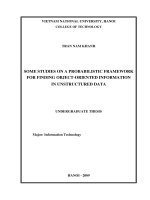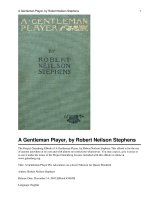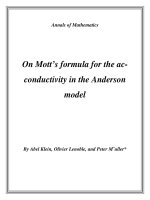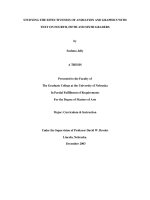CHATS ON HOUSEHOLD CURIOS BOOKS FOR COLLECTORS potx
Bạn đang xem bản rút gọn của tài liệu. Xem và tải ngay bản đầy đủ của tài liệu tại đây (616.85 KB, 261 trang )
CHATS ON HOUSEHOLD CURIOS
BOOKS FOR COLLECTORS
_With Frontispieces and many Illustrations
Large Crown 8vo, cloth._
CHATS ON ENGLISH CHINA.
By Arthur Hayden.
CHATS ON OLD FURNITURE
By Arthur Hayden.
CHATS ON OLD PRINTS.
By Arthur Hayden.
CHATS ON COSTUME.
By G. Woolliscroft Rhead.
CHATS ON OLD LACE AND NEEDLEWORK.
By E. L. Lowes.
CHATS ON ORIENTAL CHINA.
By J. F. Blacker.
CHATS ON OLD MINIATURES.
By J. J. Foster, F.S.A.
CHATS ON ENGLISH EARTHENWARE.
By Arthur Hayden.
CHATS ON AUTOGRAPHS.
By A. M. Broadley.
CHATS ON PEWTER.
By H. J. L. J. Massé, M.A.
CHATS ON POSTAGE STAMPS.
By Fred. J. Melville.
CHATS ON OLD JEWELLERY AND TRINKETS.
By MacIver Percival.
CHATS ON COTTAGE AND FARMHOUSE FURNITURE.
By Arthur Hayden.
CHATS ON OLD COINS.
By Fred. W. Burgess.
CHATS ON OLD COPPER AND BRASS.
By Fred. W. Burgess.
CHATS ON HOUSEHOLD CURIOS.
By Fred. W. Burgess.
_In Preparation._
CHATS ON BARGAINS.
By Charles E. Jerningham.
CHATS ON JAPANESE PRINTS.
By Arthur Davison Ficke.
CHATS ON OLD CLOCKS AND WATCHES.
By Arthur Hayden.
CHATS ON OLD SILVER.
By Arthur Hayden.
LONDON: T. FISHER UNWIN.
NEW YORK: F. A. STOKES COMPANY.
* * * * *
[Illustration: FIG. 1 OLD FIREPLACE, SHOWING SUSSEX BACK, ANDIRONS,
AND TRIVET.
Frontispiece.]
* * * * *
CHATS ON
HOUSEHOLD CURIOS
BY
FRED. W. BURGESS
AUTHOR OF "CHATS ON OLD COINS," "CHATS ON OLD
COPPER AND BRASS," ETC.
WITH 94 ILLUSTRATIONS
LONDON
T. FISHER UNWIN
ADELPHI TERRACE
_First published in 1914_
(_All rights reserved_)
PREFACE
There is a peculiar charm about the relics found in an old home a home
from which many generations of fledglings have flown. As each milestone
in family history is passed some once common object of use or ornament
is dropped by the way. Such interesting mementoes of past generations
accumulate, and in course of time the older ones become curios.
It is to create greater interest in these old-world odds and ends some
of trifling value to an outsider, others of great intrinsic worth that
this book has been written. The love of possession is to some possessors
the chief delight; to others knowledge of the original purposes and uses
of the objects acquired affords still greater pleasure. My intention has
been rather to assist the latter class of collectors than to facilitate
the mere assemblage of additional stores of curiosities. It is truly
astonishing how rapidly the common uses of even household furnishings
and culinary utensils are forgotten when they are superseded by others
of more modern type.
The modern art of to-day and the revival of the much older furniture of
the past have driven out the household gods of intermediate dates, and
it is in that period intervening between the two extremes that most of
the household curios reviewed in this work are found. Although many of
the finest examples of household curios are now in museums, private
collectors often possess exceptional specimens, and sometimes own the
most representative groups of those things upon which they have
specialized.
The examples in this book have been drawn from various sources. As in
"Chats on Old Copper and Brass" (which may almost be regarded as a
companion work), the illustrations are taken from photographs of typical
museum curios and objects in private collections, or have been specially
sketched by my daughter, who has had access to many interesting
collections, to the owners of which I am indebted for the illustrations
I am able to make use of.
My thanks are due to the Directors of the British Museum, who have
allowed their printers, the University Press, Oxford, to supply electros
of some exceptional objects now in the Museum; also to the Director of
the Victoria and Albert Museum, at South Kensington; and the Director
of the London Museum, now located at Stafford House.
Dr. Hoyle, the Director of the National Museum of Wales, at Cardiff, has
most kindly had specially prepared for this work quite a number of
photographs of very uncommon household curios. The Curator of the Hull
Museum has loaned blocks, and photographs have been sent by Messrs. Egan
and Co., Ltd., of Cork; Mr. Wayte, of Edenbridge; and Mr. Phillips, of
the Manor House, Hitchin. To Mr. Evans, of Nailsea Court, Somerset, I am
indebted for the loan of his unrivalled collection of ancient
nutcrackers, some of which have been sketched for reproduction. I have
also made use of examples in the collections of private friends, and
illustrated some of my own household curios, many of them family relics.
The story of domestic curios is made the more useful by these
illustrations, and also by references to well-known collections. There
is much to admire in the once common objects of the home, now curios,
and it is in the hope that some may be led to appreciate more the
antiques with which they are familiar that these pages have been penned.
If that is achieved my object will have been accomplished.
FRED. W. BURGESS.
LONDON, 1914.
CONTENTS
PAGE
PREFACE 7
CHAPTER I
THE LOVE OF THE ANTIQUE 19
No place like home Curios in the making The influence of
prevailing styles A cultivated taste.
CHAPTER II
THE INGLE SIDE 33
Fire-making appliances Tinder boxes The fireplace Andirons and
fire-dogs Sussex backs Fireirons and fenders Trivets and
stools Bellows.
CHAPTER III
THE LIGHTS OF FORMER DAYS 59
Rushlights and holders Candles, moulds, and boxes Snuffers, trays,
and extinguishers Oil lamps Lanterns.
CHAPTER IV
TABLE APPOINTMENTS 77
Cutlery: Knives, forks, and spoons Salt cellars Cruet
stands Punch and toddy Porringers and cups Trays and
waiters The tea table Cream jugs Sugar tongs and
nippers Caddies Cupids Nutcrackers Turned woodware.
CHAPTER V
THE KITCHEN 121
The kitchen grate Boilers and kettles Grills and
gridirons Cooking utensils Warming pans.
CHAPTER VI
HOME ORNAMENTS 147
Mantelpiece ornaments Vases Derbyshire Spars Jade or spleen
stone Wood carvings Old gilt.
CHAPTER VII
GLASS AND ENAMELS 173
Waterford, Bristol, and Nailsea Ornaments of glass Enamels on
metal.
CHAPTER VIII
LEATHER AND HORN 185
Spanish leather Cuir boulli work Tapestry and upholstery Leather
bottles and drinking vessels Leather curios Shoes Horn work.
CHAPTER IX
THE TOILET TABLE 199
The table and its secrets Combs Patch boxes Enamelled
objects Perfume boxes and holders Dressing
cases Scratchbacks Toilet chatelaines Locks of hair Jewel
cabinets.
CHAPTER X
THE OLD WORKBOX 223
Spinning wheels Materials and work Little
accessories Cutlery Quaint woodwork The needlewoman Old
samplers.
CHAPTER XI
THE LIBRARY 251
From cover to cover Old scrap books Almanacs The writing table.
CHAPTER XII
THE SMOKER'S CABINET 269
Old pipes Pipe racks Tobacco boxes Smokers' tongs and
stoppers Snuff boxes and rasps.
CHAPTER XIII
LOVE TOKENS AND LUCKY EMBLEMS 281
Amulets Horse trappings Emblems of luck Love spoons Glass
curios.
CHAPTER XIV
THE MARKING OF TIME 295
Clocks Watches Watch keys Watch stands.
CHAPTER XV
MUSICAL INSTRUMENTS 309
Early examples Whistles and pipes Violins and harps.
CHAPTER XVI
PLAY AND SPORT 319
Dolls Toys Old games Outdoor amusements Relics of sport.
CHAPTER XVII
MISCELLANEOUS 337
Dower chests Medicine chests Old lacquer The tool chest Egyptian
curios Ancient spectacles Curious chinaware Garden curios The
mounting of curios Obsolete household names.
INDEX 357
LIST OF ILLUSTRATIONS
FIG.
1. OLD FIREPLACE, SHOWING SUSSEX BACK, ANDIRONS, AND TRIVET
_Frontispiece_
PAGE
2. ANDIRONS WITH RATCHETS 27
3. ORNAMENTED CRESSET DOGS 27
4. TELESCOPIC RUSH AND CANDLE HOLDER 27
5. RATCHET RUSH AND CANDLE HOLDER 27
6. ANCIENT ROMAN FIRE-DOG 37
7. SUSSEX GRATE BACK, DATED 1588 37
8. THREE SINGLE DOGS OR ANDIRONS 45
9. PAIR OF DATED SUSSEX ANDIRONS (1625) 45
10. PAIR OF SUSSEX ANDIRONS 45
11. SUSSEX BACK WITH ROYAL EMBLEMS 51
12. SUSSEX BACK WITH ARMS AND ROYAL INITIALS 51
13. FINE CARVED WALNUT WOOD BELLOWS 55
14. THREE RUSHLIGHT HOLDERS 63
15. THREE VARIETIES OF OLD OIL LAMPS 63
16. TWO WALNUT WOOD FLOOR-CANDLESTICKS 69
17. FINE PAIR OF ANCIENT SNUFFERS 73
18. HANDSOMELY DECORATED KNIFE CASE AND CONTENTS
81
19. KNIFE, FORK, AND SPOON 87
20. PAIR OF DECORATED SPOONS 93
21. TWO WOODEN CUPS 101
22. WOODEN FLAGON, WITH COPPER BANDS 101
23. A COCOANUT CUP (SILVER-MOUNTED) 101
24. A COCOANUT CUP (SILVER-MOUNTED) 101
25. COCOANUT FLAGON 101
26. EARLY ENGLISH BRONZE EWER 109
27. INSCRIBED SEVENTEENTH-CENTURY WOOD DRINKING CUP
115
28-30. EARLY CARVED WOOD NUTCRACKERS 115
31-34. MEDIÆVAL WOOD NUTCRACKERS 119
35-39. EARLY STEEL AND BRASS NUTCRACKERS 119
40. TWO ANTIQUE WARMING PANS 124
41. WELSH KITCHEN FIREPLACE 124
42. MECHANICAL ROASTING JACKS 127
43-46. GRIDIRONS SHOWING FOREIGN INFLUENCE IN DESIGN 131
47 AND 48. TWO WOODEN FOOD BOXES 135
49. A COLLECTION OF IRON FAT BOATS AND GREASE PANS 135
50. WOODEN COFFEE CRUSHERS AND PESTLES AND MORTAR
139
51. APPLE SCOOPS OF BONE 139
52. WOODEN PIGGINS AND PORRIDGE BOWL 143
53. WOODEN PLATTER, BOWL, AND SPOONS 143
54. BRASS CHIMNEY ORNAMENT (ONE OF A PAIR) 151
55. BLACK AND GOLD DERBYSHIRE MARBLE VASE 155
56. TEMPLE GUARDIAN, CARVED FROM THE GNARLED ROOT OF A TREE
159
57. CARVED PLAQUE STAND 163
58 AND 59. MINIATURE COPPER AND SILVER KETTLES 167
60. MINIATURE IVORY COFFEE BOILER 167
61. TWO OLD-GILT JEWELLED ORNAMENTS 167
62. THREE FINE OLD IVORIES 171
63. BATTERSEA ENAMELS 179
64. ANTIQUE DRESSING OR TOILET GLASS 202
65. THREE OLD SCRATCHBACKS 209
66. SILVER CHATELAINE TOILET INSTRUMENTS 209
67. ANOTHER CHATELAINE SET 209
68. FINE ORIENTAL LACQUERED BOX 217
69. SMALL LACQUER CABINET 217
70. A PAGODA-SHAPED CASKET 217
71. DECORATED JEWEL CASE 217
72. OLD SPINNING WHEEL 227
73. SPINNING WHEEL 233
74. OLD LACE BOBBINS 233
75. OLD PIN POPPETS AND ANCIENT PINS 237
76. THREE OLD WORKBOXES 243
77. OLD WORKBOX FITTINGS 247
78. ANCIENT CLOG ALMANAC 257
79. OLD COIN TESTER 265
80. MINIATURE SOUVENIR ALMANAC 265
81. ANCIENT WRITING SET 265
82. THREE CURIOUS PIPE-STOPPERS 275
83. BRASS TOBACCO BOX 275
84. COLLECTION OF HARNESS AMULETS AND TEAM BELLS 285
85. OLD WELSH LOVE SPOONS 291
86. FINE GOTHIC FRENCH CLOCK 299
87. SPECIMENS OF OLD WATCH KEYS 303
88. TWO ANTIQUE WATCH CASES 303
89. OLD SPINET 315
90. CURIOUS TYPES OF WHISTLES 323
91. QUAINT OLD TOY 323
92. A POWDER TESTER 335
93. A PRIMING FLASK 335
94. OLD POWDER FLASKS 343
I
THE LOVE OF THE ANTIQUE
CHAPTER I
THE LOVE OF THE ANTIQUE
No place like home Curios in the making The influence of
prevailing styles A cultivated taste.
There is an inborn love of the antique in most men, although some are
fond of asserting that their interests are bound up in the modern, and
that they have no time to devote to the study of the antiquities of past
ages or the things that were fashionable in times long past. Yet most
people, when their secret longings are analysed, are found to have an
admiration for the old; if not a superstitious veneration, at any rate a
desire to perpetuate the memory of their ancestors and to keep in mind
the things with which they were familiar. The wealthy man of to-day, who
may have sprung from the people, secretly, if not openly, endeavours to
surround himself with household gods which tell of a longer past and a
closer relationship with the well-to-do than he can legitimately claim.
In the pursuit of such things many a man has found his hobby; and there
are few men who do not find recreation and delight in a hobby of some
kind. Such interests outside their regular occupations broaden their
outlook and widen their knowledge. Some hobbies tend to lead to
specialization, and the specialist is apt to become warped and narrowed;
not so, however, the collector of household curios.
No Place Like Home.
It would be difficult to find greater delight than that which centres in
those things that concern the home and home life. The love of the old
homestead and the goods and chattels it contains is ingrained in the
breast of every Britisher; and although families become scattered and
some of their members find homes of their own beyond the seas, they find
the greatest delight in the objects with which they were familiar in
years gone by, and venerate the relics of former generations the
household gods which have been handed on from father to son.
It is not the intrinsic value of the household curio that is its chief
charm; it is rather the knowledge that its long association with those
who have claimed its ownership from the time when it was "new" has made
it truly a family relic. These thoughts, being so deeply rooted in the
minds of most men and women, foster the love of household curios and
intensify the interest shown in their possession.
To all it is not given to own family relics; neither would they serve to
satiate the ambition of the true collector, although they might form the
nucleus of his collection. He seeks other treasures in the town and in
the country and wherever such things are offered for sale.
Curios in the Making.
The domestic habits of the people of this and other civilized countries
have been the outcome of a slow process of upbuilding. There has been no
sudden change; in all grades and under every different social condition,
at every period, the improvement of the furnishings of the home has been
one of gradual and, for the most part, steady progress.
There was a time when, beyond the bare furniture, tapestry hangings,
tools of the craftsmen, and weapons of the warrior, there were few
household goods of a portable nature. In mediæval England the oak chest
was sufficient to contain the valuables of a large household; and very
often beyond a cabinet or sideboard or corner cupboard there were few
receptacles where anything of value could be safeguarded. The dower
chest, in which the bride brought to her husband household linen and her
stock of clothing, and in the wooden compartment in one corner of the
chest her jewels and coin of the realm if she possessed any was then a
prominent piece of furniture. The oak chest, rendered formidable with
its massive lock and bolts, opened with a ponderous key, was the chosen
receptacle in after-years as a treasure chest, and regarded as the
safest place in which to keep valuable documents and other property. In
the Public Record Office may be seen the old iron box in which the
Domesday Book was kept for many centuries. The old City Companies have
their treasure chests still; and boxes studded over with iron nails and
fitted with large hasps and locks are pointed out in many old houses as
passports to family standing.
The household curios which a collector seeks include objects of utility
and ornament. Many of them are associated with household work, and quite
a number of one-time kitchen and culinary utensils, as well as those
which were once cherished in the best parlour or withdrawing-room, are
found places among such curios. During the last few years domestic
architecture has passed through several stages of advancement. The stiff
and formal Georgian houses, the painful Victorian villas, and some of
the earlier attempts at architectural improvement have been swept away
to make room for modern replicas of still older styles which have been
revived or incorporated in the _nouvre_ art, which touches the home in
its architecture and internal decoration, as well as in its furnishings.
In modern dwellings the Elizabethan style has often been followed,
although modern conveniences have been incorporated. When furnishing
such houses with suitable replicas of the antique the householders of
the last quarter of a century have been unconsciously, perhaps,
fostering the love of household antiques and providing fitting homes for
their family curios.
The Day of the Curio Hunter.
This is admittedly the day of curio hunting, and those who specialize on
household curios have exceptional opportunities of displaying them to
better advantage than those who cared for such things in the past.
Perhaps it is because there were so few opportunities of arranging and
displaying household antiques during the last three-quarters of the
nineteenth century that many objects now treasured have been preserved
so fresh and kept in such excellent condition. The housewives of the
past generation were undoubtedly conservative in their retention of old
household goods, and it is to their careful preservation that so many
objects of interest, although perhaps fully a century old, come to the
collector in such perfect condition.
The patient labour expended by the amateur artist, the needleworker, and
the connoisseur of home art a generation or two ago has provided the
collector to-day with an exceptionally interesting class of curio, for
there is much to admire in amateur craftsmanship, and especially in the
handiwork of the needlewoman and the weaver and decorator of so many
beautiful textiles which have been preserved to us. Sentiment was strong
in the early nineteenth century, and among the love tokens of that day,
chiefly the work of amateurs, some very beautiful and unique curios were
produced. These, too, have come down to the collector of the twentieth
century, and help him to secure specimens representing every decade, so
that in a large collection, carefully selected, the slow and yet sure
progress made in the fine arts, and the improvement in the ornamental
surroundings in the home, is made clear. In each one of the different
groups into which household curios may be divided there are many
distinctive objects, all of which are in themselves interesting, but
when viewed in association with other things which have been used at
contemporary periods, or associated with the home life of persons
similarly situated, but dwelling in different localities, are doubly
interesting.
The Influence of Prevailing Styles.
In determining the origin of curios, and defining the periods during
which they have been made, it is useful to have at least a little
knowledge of the influence or character of the prevailing styles in the
countries of origin. French art has exercised a great influence upon the
productions of other nations; it has also been moulded by the curios and
other articles of foreign origin then being sold in France. Regal and
political influence have left their mark upon almost every period of
French art, and have had much to do with the contemporary art of other
nations, for France was for centuries a guide in most of the fine arts,
and especially in those things which tended towards decorative effect.
The furniture of France may be said to be an exponent of the country's
history, so great has been the connection between French art, controlled
by passing events, and its commercial products. It is said that the
State pageants of the Louis XIV period tended to raise the tone of the
work of French artisans and to encourage artists. That was a period of
great development, for in the year 1670 the famous tapestry factories
sprang into existence; and it must be admitted that the designing of
those wonderful textiles influenced the manufacturers of furniture and
smaller objects both in France and in other countries.
[Illustration: FIG. 2 ANDIRONS WITH RATCHETS.
FIG. 3 ORNAMENTED CRESSET DOGS.
FIG. 4 TELESCOPIC RUSH AND CANDLE HOLDER.
FIG. 5 RATCHET RUSH AND CANDLE HOLDER.]
Sir Christopher Wren is reputed to have been carried away by the
influence of the Louis XIV art. It was in that King's reign, too, that
Charles Boule perfected his veneers of tortoiseshell and fine brass
work. Buhl cabinets, fancy boxes, and many smaller objects found their
way into this country, and are now household curios. When Philip of
Orleans was Regent of France Boule introduced vermilion and gold-leaf as
the groundwork upon which to throw up the beauty of tortoiseshell, and
his designs became lavishly extravagant. Of these there are some
beautiful examples extant; one, a facsimile of a bureau made in Paris in
1769, so elaborate that its cost was reputed to have been about £20,000,
is to be seen in the Wallace Collection at Hertford House. In the reign
of Louis XV great encouragement was given to the importation of lacquer
work from China, influencing the creation of similar works in France;
and it was owing to his support that the Vernis Martin enamels or
varnishes were produced. Then came those beautiful paintings of
landscapes with which so many of the rarer household curios dating from
that period were ornamented.
The French style came over the Channel. Thus it was that French
influence, as shown in its art in which its political history was
reflected, permeated into the workshops of England. Then came the
popularity of the designs of the Adam Brothers and Sheraton. During the
Revolution in France art was at a standstill, but as soon as Napoleon
had established his Empire artistic France began again, and we see its
influence in the Empire ornament of furniture and curios. Perhaps one of
the most striking instances of change in style was that in our own
country when the Prince of Orange came over and William and Mary were
crowned King and Queen. Dutch influence on the art of Great Britain was
immediately seen, and in the curios of that period there is a remarkable
difference between those produced at that time, when Englishmen were
content to allow the art of another nation to dominate their work, and
those of an earlier date. Dutch marquetry is seen in cabinets and
smaller household antiques in the manufacture of which panels were
applicable. There was a change in design about the year 1695, just after
Mary died, the characteristic seaweed following the floral, as if the
very flowers had been banished after the Queen's death. The influence of
the King and of his successors was very noticeable in the style and
decoration of household goods; the history of this country at that time,
just as the history of France had been, was reflected in the art of its
craftsmen.
A Cultivated Taste.
The love of the antique is regarded by some as a cultivated taste. The
specialization upon any one branch of household curios may justly be
regarded as such, but surely not the regard, almost reverence, for
family relics, although they are but the common things of everyday life!
Their collection stimulates the connoisseur, and encourages him to fresh
exertions, and in that sense the habit of keeping a keen look out for
anything that may illumine previous researches or add greater lustre to
those things already secured, is gradually cultivated.
Household curios are not unassociated with the folklore of the district
where such objects have been made, or were commonly in use; and the very
names of many things, the uses of which are almost forgotten, are
suggestive of former occupations and older methods of practising
household economy and the preparation of food. It is common knowledge
that the purest old English is met with in the dialects of the
countryside, and oftentimes once household words, now lost in modern
speech, are found again when the old names or original purposes of the
curios remaining to us are discovered. The cultivation of a taste for
gathering together household antiques is much to be desired, and in the
pursuit of such knowledge there is great pleasure and as the value of
genuine antiques is ever rising, some profit, too.
II
THE INGLE SIDE
CHAPTER II
THE INGLE SIDE
Fire-making appliances Tinder boxes The fireplace Andirons
and fire-dogs Sussex backs Fireirons and fenders Trivets and
stools Bellows.
In winter the ingle side, or its equivalent in a modern house, appears
to be the chief centre of attraction. It was ever so; and to-day the
lessened necessity for crowding round the fire and sitting in the ingle
nook, owing to modern methods of distributing the heat, in no way
lessens the attraction which draws an Englishman to the fire. In the
United States of America stoves of various kinds are deemed good
substitutes, but in this country the open fire is preferred, and modern
scientific research aims at perfecting and improving existing accepted
methods of heating and warming rooms rather than of displacing them.
In the days when the earliest collectable curios of the ingle side were
being made by the village smith, and the local sculptor and mason were
preparing the chimney corner and the mantelpiece to surround the
fireplace, it was in front of the great open fire in the kitchen,
before which the large joints were roasted, that the retainers of the
baron and the landowner or lord of the manor assembled on winter nights.
It was around the fire which crackled on the hearth in the great hall
that the more favoured ones forgathered, and in the lesser homestead the
family drew up their chairs and found seats in the ingle nook, near the









